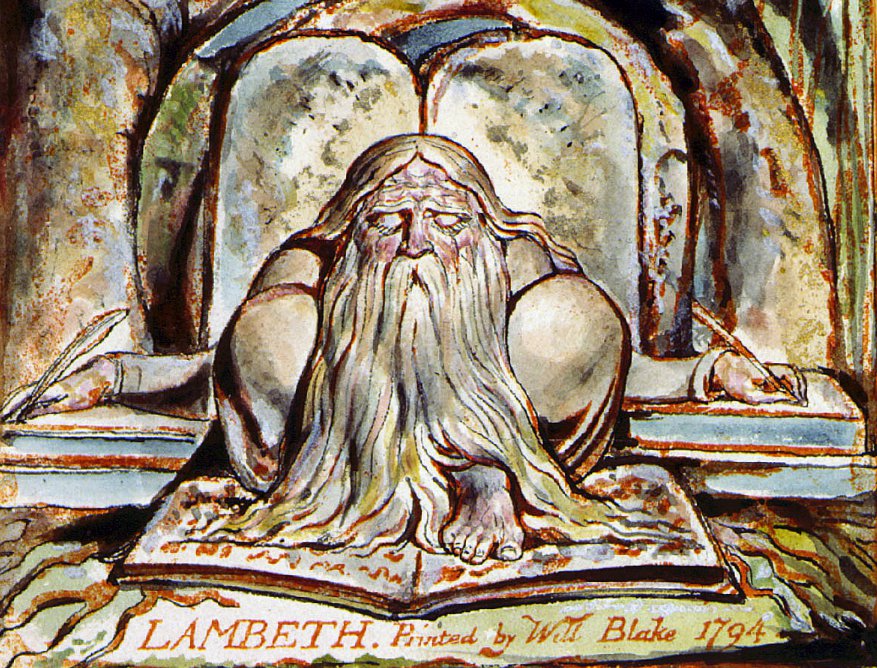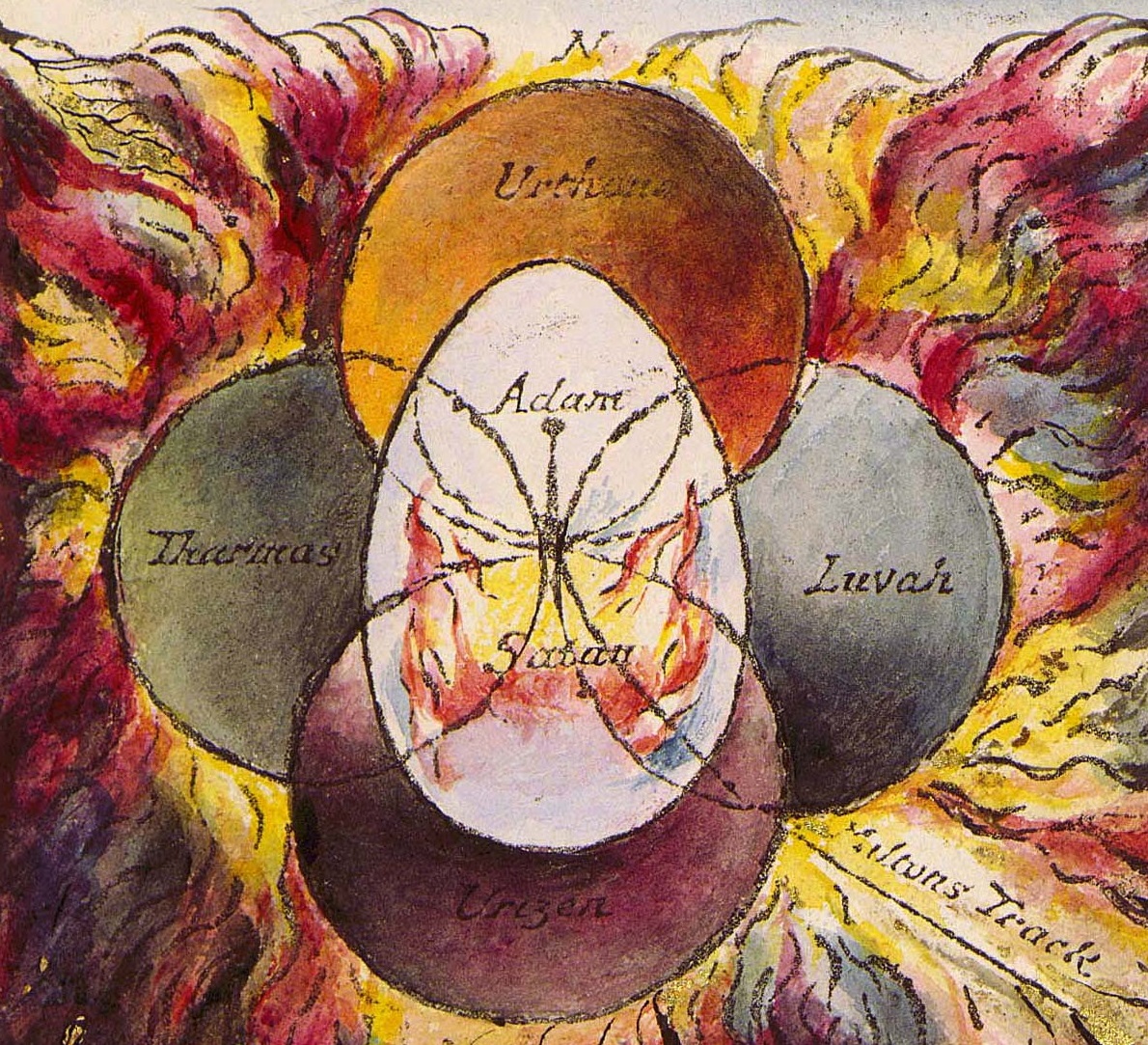|
Thiriel
In the mythological writings of William Blake, Thiriel is the first son of Urizen. There is a possible confusion with ''Tiriel'', the protagonist of the first prophetic book, of that name. In ''The Book of Urizen'', Thiriel has an explicit identification of his place as Air in the Four Elements, matched to Urizen's four sons. His birth is described in Chapter VIII: :Most Urizen sicken'd to see :His eternal creations appear, :Sons and daughters of sorrow, on mountains, :Weeping, wailing. First Thiriel appear'd, :Astonish'd at his own existence, :Like a man from a cloud born Thiriel appears also in ''The Four Zoas'', where he becomes Palamabron Palamabron is a character in William Blake's mythology, representing pity. He is the brother of Rintrah (wrath), Bromion (scientific thought) and Theotormon (desire/jealousy), represented together as either the Sons of Los or of Jerusalem .... At the end of the Seventh Night, we read: :Urizen became Rintrah Thiriel became P ... [...More Info...] [...Related Items...] OR: [Wikipedia] [Google] [Baidu] |
Urizen
In the mythology of William Blake, Urizen () is the embodiment of conventional reason and law. He is usually depicted as a bearded old man; he sometimes bears architect's tools, to create and constrain the universe; or nets, with which he ensnares people in webs of law and conventional society. Originally, Urizen represented one half of a two-part system, with him representing reason and Los, his opposition, representing imagination. In Blake's reworking of his mythic system, Urizen is one of the four ''Zoas'' that result from the division of the primordial man, Albion, and he continues to represent reason. He has an Emanation, or paired female equivalent, Ahania, who stands for Pleasure. In Blake's myth, Urizen is joined by many daughters with three representing aspects of the body. He is also joined by many sons, with four representing the four elements. These sons join in rebellion against their father but are later united in the Last Judgment. In many of Blake's books, Urize ... [...More Info...] [...Related Items...] OR: [Wikipedia] [Google] [Baidu] |
Tiriel
''Tiriel'' is a narrative poem by William Blake, written ''c.''1789. Considered the first of his prophetic books, it is also the first poem in which Blake used free septenaries, which he would go on to use in much of his later verse. ''Tiriel'' was unpublished during Blake's lifetime and remained so until 1874, when it appeared in William Michael Rossetti's ''Poetical Works of William Blake''.Damon (1988: 405) Although Blake did not engrave the poem, he did make twelve sepia drawings to accompany the rough and unfinished manuscript, although three of them are considered lost as they have not been traced since 1863.Bentley (1967) Synopsis Many years before the poem begins, the sons of Har and Heva revolted and abandoned their parents. Tiriel subsequently set himself up as a tyrant in the west, driving one of his brothers, Ijim, into exile in the wilderness, and chaining the other, Zazel, in a cave in the mountains. Tiriel then made slaves of his own children, until eventually ... [...More Info...] [...Related Items...] OR: [Wikipedia] [Google] [Baidu] |
The Book Of Urizen
''The Book of Urizen'' is one of the major prophetic books of the English writer William Blake, illustrated by Blake's own plates. It was originally published as ''The First Book of Urizen'' in 1794. Later editions dropped the "First". The book takes its name from the character Urizen in Blake's mythology, who represents alienated reason as the source of oppression. The book describes Urizen as the "primeaval priest" and narrates how he became separated from the other Eternals to create his own alienated and enslaving realm of religious dogma. Los and Enitharmon create a space within Urizen's fallen universe to give birth to their son Orc, the spirit of revolution and freedom. In form the book is a parody of the Book of Genesis. Urizen's first four sons are Thiriel, Utha, Grodna and Fuzon (respectively elemental Air, Water, Earth, Fire, according to Chapter VIII). The last of these plays a major role in ''The Book of Ahania'', published in 1795. Background In autumn 1790 Bla ... [...More Info...] [...Related Items...] OR: [Wikipedia] [Google] [Baidu] |
Birth Of The Sons Of Urizen
Birth is the act or process of bearing or bringing forth offspring, also referred to in technical contexts as parturition. In mammals, the process is initiated by hormones which cause the muscular walls of the uterus to contract, expelling the fetus at a developmental stage when it is ready to feed and breathe. In some species the offspring is precocial and can move around almost immediately after birth but in others it is altricial and completely dependent on parenting. In marsupials, the fetus is born at a very immature stage after a short gestation and develops further in its mother's womb pouch. It is not only mammals that give birth. Some reptiles, amphibians, fish and invertebrates carry their developing young inside them. Some of these are ovoviviparous, with the eggs being hatched inside the mother's body, and others are viviparous, with the embryo developing inside her body, as in the case of mammals. Mammals Large mammals, such as primates, cattle, horses, some ant ... [...More Info...] [...Related Items...] OR: [Wikipedia] [Google] [Baidu] |
William Blake's Mythology
The prophetic books of the English poet and artist William Blake contain an invented mythology, in which Blake worked to encode his spiritual and political ideas into a prophecy for a new age. This desire to recreate the cosmos is the heart of his work and his psychology. His myths often described the struggle between enlightenment and free love on the one hand, and restrictive education and morals on the other. Sources Among Blake's inspirations were John Milton's ''Paradise Lost'' and ''Paradise Regained'', the visions of Emanuel Swedenborg and the near-cabalistic writings of Jakob Böhme. Blake also included his own interpretations of druidism and paganism. The Fall of Albion The longest elaboration of this private myth-cycle was also his longest poem, '' The Four Zoas: The Death and Judgment of Albion The Ancient Man'', written in the late 1790s but left in manuscript form at the time of his death. In this work, Blake traces the fall of Albion, who was "originally fourfold b ... [...More Info...] [...Related Items...] OR: [Wikipedia] [Google] [Baidu] |
William Blake
William Blake (28 November 1757 – 12 August 1827) was an English poet, painter, and printmaker. Largely unrecognised during his life, Blake is now considered a seminal figure in the history of the poetry and visual art of the Romantic Age. What he called his " prophetic works" were said by 20th-century critic Northrop Frye to form "what is in proportion to its merits the least read body of poetry in the English language". His visual artistry led 21st-century critic Jonathan Jones to proclaim him "far and away the greatest artist Britain has ever produced". In 2002, Blake was placed at number 38 in the BBC's poll of the 100 Greatest Britons. While he lived in London his entire life, except for three years spent in Felpham, he produced a diverse and symbolically rich collection of works, which embraced the imagination as "the body of God" or "human existence itself". Although Blake was considered mad by contemporaries for his idiosyncratic views, he is held in high regard b ... [...More Info...] [...Related Items...] OR: [Wikipedia] [Google] [Baidu] |
Classical Elements
Classical elements typically refer to earth, water, air, fire, and (later) aether which were proposed to explain the nature and complexity of all matter in terms of simpler substances. Ancient cultures in Greece, Tibet, and India had similar lists which sometimes referred, in local languages, to "air" as "wind" and the fifth element as "void". These different cultures and even individual philosophers had widely varying explanations concerning their attributes and how they related to observable phenomena as well as cosmology. Sometimes these theories overlapped with mythology and were personified in deities. Some of these interpretations included atomism (the idea of very small, indivisible portions of matter), but other interpretations considered the elements to be divisible into infinitely small pieces without changing their nature. While the classification of the material world in ancient Indian, Hellenistic Egypt, and ancient Greece into Air, Earth, Fire and Water was ... [...More Info...] [...Related Items...] OR: [Wikipedia] [Google] [Baidu] |
Vala, Or The Four Zoas
''Vala, or The Four Zoas'' is one of the uncompleted prophetic books by the English poet William Blake, begun in 1797. The eponymous main characters of the book are the Four Zoas (Urthona, Urizen, Luvah and Tharmas), who were created by the fall of Albion in Blake's mythology. It consists of nine books, referred to as "nights". These outline the interactions of the Zoas, their fallen forms and their Emanations. Blake intended the book to be a summation of his mythic universe but, dissatisfied, he abandoned the effort in 1807, leaving the poem in a rough draft and its engraving unfinished. The text of the poem was first published, with only a small portion of the accompanying illustrations, in 1893, by the Irish poet W. B. Yeats and his collaborator, the English writer and poet Edwin John Ellis, in their three-volume book '' The Works of William Blake''. Background Blake began working on ''Vala, or The Death and Judgement of the Eternal Man: A Dream of Nine Nights'' while he wa ... [...More Info...] [...Related Items...] OR: [Wikipedia] [Google] [Baidu] |
Palamabron
Palamabron is a character in William Blake's mythology, representing pity. He is the brother of Rintrah (wrath), Bromion (scientific thought) and Theotormon (desire/jealousy), represented together as either the Sons of Los or of Jerusalem Jerusalem (; he, יְרוּשָׁלַיִם ; ar, القُدس ) (combining the Biblical and common usage Arabic names); grc, Ἱερουσαλήμ/Ἰεροσόλυμα, Hierousalḗm/Hierosóluma; hy, Երուսաղեմ, Erusałēm. i .... William Blake's mythology {{poetry-stub ... [...More Info...] [...Related Items...] OR: [Wikipedia] [Google] [Baidu] |




.jpg)

